~ ~ ~
Estos anuncios son interactivos. Toque en ellos para seguir a las páginas de web
El Istmo de Panamá se sumó tarde al movimiento de Independencia de Hispanoamérica. Aquí no hubo rastros de un movimiento autonomista sino hasta 1820, y la primera declaratoria de independencia no llegó sino hasta noviembre de 1821, cuando ya el proceso estaba consolidado en esta parte del continente. Las razones del independentismo tardío panameño son varias y pueden ser encontradas en la obra Apuntamientos Históricos (1801 – 1840), de Mariano Arosemena.
La familia Arosemena pertenecía a la élite criolla del Istmo de Panamá, dedicada al comercio. Mariano jugó un papel primordial, como editor del primer periódico local, de inclinaciones liberales, fue uno de los actores clave de la proclama del 28 de Noviembre de 1821, pagando a las tropas españolas para que se retiraran hasta La Habana.
Por varios factores: crisis demográfica en el Istmo, de la cual se deduce la ausencia de producción agrícola o artesanal, con la consecuente debilidad de los actores sociales que fueron decisivos en otras regiones (artesanos, esclavos y masas de campesinos indígenas); su situación geopolítica que la convirtió en fortín español; y un criollismo dedicado al comercio, con la capacidad de adaptación oportunista que es característica de esta clase social.
Un cúmulo de circunstancias convencieron a los criollos panameños de pasarse al bando de la Independencia: el 28 de enero Maracaibo proclamó su independencia; el 6 de mayo, se crea la Gran Colombia; en julio, Sucre lucha victoriosamente por la liberación del Ecuador; ese mismo mes, San Martín concreta la independencia de Chile; el 6 de agosto se produjo la batalla de Carabobo, que selló la independencia de Venezuela; el 15 de septiembre Guatemala se declara independiente; el 27 de septiembre la ciudad de México cae en manos de Iturbide; Cartagena fue liberada el 1 de octubre.
Como consecuencia de la lógica militar, ya Simón Bolívar había ordenado que se preparara una fuerza invasora sobre el Istmo panameño organizada desde Cartagena, con 5,000 hombres y un centenar de buques que debía caer sobre Portobelo.
Al respecto dice Mariano Arosemena (“Apuntamientos históricos”): “… por manera que si no nos hubiésemos lanzado audaces los istmeños a los peligros inherentes a la proclamación de la independencia por nosotros mismos, esa gloria que supimos ganar no fuera hoi el laurel honroso que nos ennoblece”.
Para completar la dicha de nuestros comerciantes, evitándoles algún sacrificio, el virrey Sámano muere en Panamá el 3 de agosto; y el 22 de octubre, el general Murgeon se vio obligado a zarpar con el grueso de sus tropas para combatir en Ecuador, dejando el mando militar en manos del general José de Fábrega, realista, panameño y uno de los mayores terratenientes de la provincia de Veraguas, quien antes había combatido contra los patriotas de la Nueva Granda y que acabaría como “prócer” de la Independencia panameña.
Pese a todas esas buenas noticias, la élite criolla istmeña, asumía la siguiente actitud: “Sin embargo, encubríamos nuestras aspiraciones cordiales para que el capitán general (Murgeon) continuara iluso en su pretensión de que fuéramos súbditos de la monarquía, ya regenerada”.
A esas alturas (octubre) la prudencia seguía siendo la norma política: “Sobre todo, no era prudente exponer a un fracaso nuestro plan de libertad… Era el cuidado de los corifeos de la independencia istmeña prevenir todo acto inconsulto i precipitado. Teníanse, pues, reuniones secretas, dirijidas a ir madurando el gran proyecto de salvación”.
Hasta que un levantamiento popular en la Villa de Los Santos, compuesta por pequeños campesinos, vino a acabar con tanta prudencia, y el 10 de noviembre de 1821, es la primera población panameña que tuvo el valor de proclamarse independiente de España.
Décadas después, cuando Mariano escribe sus Apuntamientos, todavía conserva una crítica contra los “novicios” santeños, que realizaron un movimiento revolucionario “irregular i deficiente”, según él, puesto que se contentaron simplemente con proclamarse “independientes”, sin definir qué tipo de gobierno se daban, “ni cosa alguna sobre los negocios de la transformación política”.
Pero los criollos del Cabildo de Panamá prefirieron optar por “medidas suaves”, y no se suman a la proclama. Los comerciantes panameños no estaban dispuestos a arriesgar sus vidas, así que se decidieron por el plan más incruento: sobornar poco a poco a la tropa realista para que desertara.
En una fecha entre el 10 y el 28 de noviembre, Mariano Arosemena hace alusión, por primera vez, a otros actores sociales distintos a la élite criolla. Según él, se crean dos o tres sociedades patrióticas conformadas por “maestros de arte (artesanos) de más influjo en el pueblo, a saber: Basilio Roa, Felipe Delgado, Abad Montecer, Juan Antonio Noriega, Manuel Luna, Fernando Guillén, Bruno Agüero, Juan Berroa, Manuel Aranzasugoitía, Salvador Berrío, José María Rodríguez, Alejandro Méndez, Guillermo Brinios, Manuel Llorent, José Manuel Escartin: estos incorporaron a las sociedades mencionadas a los discípulos suyo de confianza”.
Levantamos la hipótesis altamente probable de que este sector popular fue el que aportó el brío del que carecían los comerciantes criollos, acabando con las dudas y las prudencias.
La noche del 27 de noviembre hubo una deserción masiva de soldados que constituían “casi todas” las fuerzas militares que quedaban en la ciudad. De manera que, el 28 de noviembre, “el vecindario pidió que se reuniera el Cabildo… y se reúnen en la casa consistorial… Un inmenso gentío se apoderó de la barra, mientras que la plaza de la Catedral estaba llena de habitantes de las dos parroquias… La primera proposición, sometida al debate, fue si se proclamaría la independencia de este Istmo del Gobierno de España”.
Siempre precavidos los comerciantes, dejaron en boca del presbítero Martínez hacer la propuesta de votar por la afirmativa ante la primera proposición, pero “a reserva de lo que resolvieran las Cortes del reino”.
Por suerte, cundió la razón y fue rechazada la consideración del presbítero, y entonces fue que, con once años de retraso: “Panamá, espontáneamente, i conforme al voto general de los pueblos de su comprensión. Se declara libre e independiente del Gobierno español”.
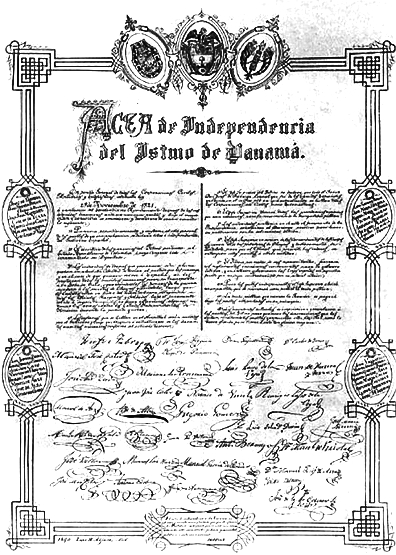
Así lo admite en una carta enviada al Centro Estratégico Latinoamericano de Geopolítica CELAG.
La Organización de los Estados Americanos (OEA) aún no dispone de la auditoría definitiva sobre las elecciones presidenciales de Bolivia celebradas el pasado 20 de octubre. Así lo admite en una carta enviada al Centro Estratégico Latinoamericano de Geopolítica CELAG, remitida tras la petición del Centro de recabar información sobre dicha auditoría.
En la misiva, con fecha de 25 de noviembre, la OEA señala que “una vez finalizado el informe definitivo” será “de consulta pública”, sin anunciar cuándo concluirá dicho trabajo. La carta está firmada por Gerardo de Icaza, director del Departamento para la Cooperación y Observación Electoral de la OEA. Este comunicado de prensa adjunta el citado escrito.
Tras más de un mes de la celebración de unas elecciones que la OEA calificó como fraudulentas, por el momento el único documento que ha presentado la organización panamericana es un informe preliminar. Este informe, que admite que sus hallazgos son “preliminares”, fue la base para establecer el supuesto fraude. El propio documento reconocía que el equipo de auditoría “continúa en este momento recibiendo y procesando gran cantidad de información”, evidenciando así su carácter transitorio.
Un análisis realizado por CELAG detectó graves inconsistencias en el informe preliminar . Ante estas irregularidades, CELAG solicitó hasta por dos veces información a la OEA sobre la metodología seguida, así como la entrega de la auditoría definitiva o bien la fecha de su publicación. Hasta el momento, ninguna de las peticiones ha sido satisfecha.
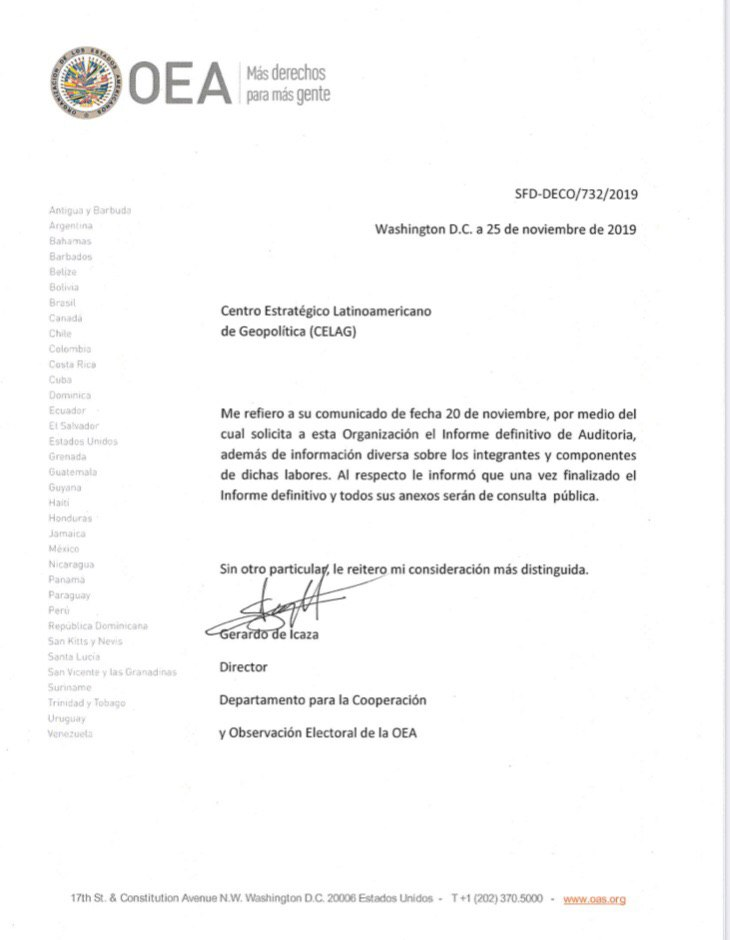
Gracie Mansion, the official residence of New York’s mayors since 1942, hosted billionaire Michael Bloomberg for three terms.
The first of these terms began after Bloomberg, then the Republican candidate for mayor, spent an incredible $74 million to get himself elected in 2001. He spent, in effect, $99 for every vote he received.
Four years later, Bloomberg — who made his fortune selling high-tech information systems to Wall Street — had to spend even more to get himself re-elected. His 2005 campaign bill came to $85 million, about $112 per vote.
In 2009, he had the toughest sledding yet. Bloomberg first had to maneuver his way around term limits, then convince a distinctly unenthusiastic electorate to give him a majority. Against a lackluster Democratic Party candidate, Bloomberg won that majority — but just barely, with 51 percent of the vote.
That majority cost Bloomberg $102 million, or $174 a vote.
Now Bloomberg has announced he’s running for president as a Democrat, arguing he has the best chance of unseating President Trump, whom he describes as an “existential threat.” Could he replicate his lavish New York City campaign spending at the national level? Could he possibly afford to shell $174 a vote nationwide — or even just $99 a vote?
Let’s do the math. Donald Trump won the White House with just under 63 million votes. We can safely assume that Bloomberg would need at least that 63 million. At $100 a vote, a victory in November 2020 would run Bloomberg $6.3 billion.
Bloomberg is currently sitting on a personal fortune worth $52 billion. He could easily afford to invest $6.3 billion in a presidential campaign — or even less on a primary.
Indeed, $6.3 billion might even rate as a fairly sensible business investment. Several of the other presidential candidates are calling for various forms of wealth taxes. If the most rigorous of these were enacted, Bloomberg’s grand fortune would shrink substantially — by more than $3 billion next year, according to one estimate.
In other words, by undercutting wealth tax advocates, Bloomberg would save over $6 billion in taxes in just two years — enough to cover the cost of a $6.3 billion presidential campaign, give or take a couple hundred million.
Bloomberg, remember, wouldn’t have to win the White House to stop a wealth tax. He would just need to run a campaign that successfully paints such a tax as a clear and present danger to prosperity, a claim he has already started making.
Bloomberg wouldn’t even need to spend $6.3 billion to get that deed done. Earlier this year, one of Bloomberg’s top advisers opined that $500 million could take his candidate through the first few months of the primary season.
How would that $500 million compare to the campaign war chests of the two primary candidacies Bloomberg fears most? Bernie Sanders raised $25.3 million in 2019’s third quarter for his campaign, Elizabeth Warren $24.6 million. Both candidates are collecting donations — from small donors — at a $100 million annual pace.
Bloomberg could spend 10 times that amount on a presidential campaign and still, given his normal annual income, end the year worth several billion more than when the year started.
Most Americans don’t yet believe that billionaires shouldn’t exist. But most Americans do believe that America’s super rich shouldn’t be able to buy elections or horribly distort their outcomes.
But unfortunately, they can — or at least, you can be sure they’ll try.
Contact us by email at fund4thepanamanews@gmail.com
These links are interactive — click on the boxes
The Varela Leaks are quite alarming, both in their content, which is surely edited, and because the fact that these interceptions were made at all plus other known data suggest that there is a paramilitary right-wing electronic surveillance operation ongoing in Panama right now.
The biggest national security / national sovereignty alarm in the content so far? WhatsApp chatter which indicates that China paid Varela a $143 million bribe to break relations with Taiwan and establish formal ties with the Beijing government.
The intercepted communications with the former American ambassador are other alarms of this sort. The content ougtht to be alarming to patriotic Panamanians. (For other reasons, as a matter of security procedurees, Feeley’s intercepted chats with Varela should be taken as a serious matter among American diplomats.)
On the point of the apparent Chinese bribe, we are bound to hear all manner of “Well, what about…?” stuff. Maybe the current bochinche that Cortizo has vetted his new attorney general pick with the US government will be part of that.
And what, really, of the Odebrecht scandal? Yes, a private Brazilian coporation, but one that was promoted by the Brazilian state. A
And the intercepts themselves, and the prior case ending in Ricardo Martinellis corrupt acquittal? The company that provided that capability arose out of the State of Israel’s security apparatus, its sales have been promoted by the Israeli government and since 2014 it has come under the control of a US-based hedge fund
All of this suggests that those of us seriously interested in a new Panamanian constitution that’s not about keeping the current thuggish gravy train rolling. We need to take up the entire matter of defending national sovereignty. It’s not contemplated in any modern and realistic way in the current constitution.
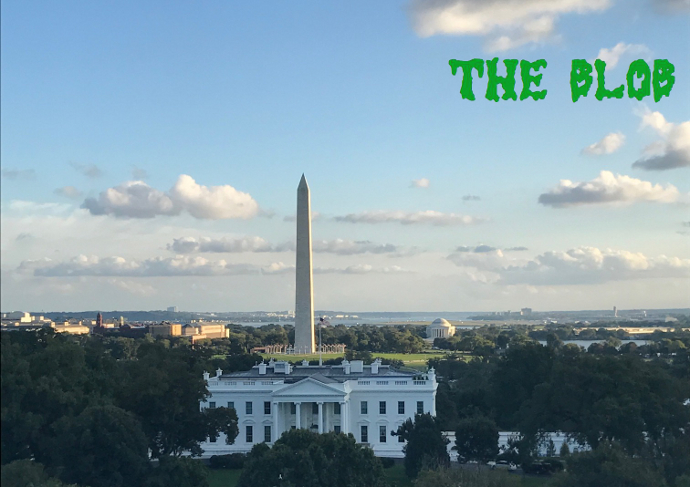
WONDERFFUL stuff for conspiracy theorists!
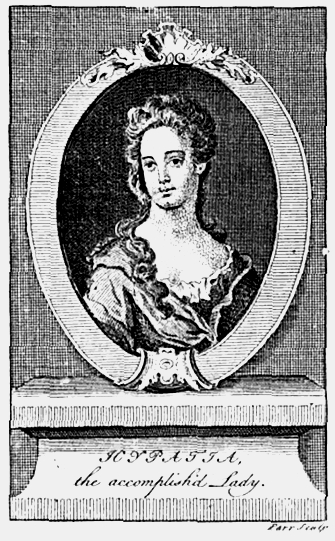
Fables should be taught as fables, myths as myths, and miracles as poetic fantasies. To teach superstitions as truths is a most terrible thing. The child mind accepts and believes them, and only through great pain and perhaps tragedy can he be in after years relieved of them.
Hypatia of Alexandria (attributed)
Men who never get carried away should be.
Malcolm Forbes
Sometimes it falls upon a generation to be great. You can be that great generation.
Nelson Mandela
Boring people don’t have to stay that way.
Hedy Lamarr
Contact us by email at fund4thepanamanews@gmail.com
These links are interactive — click on the boxes
The first part of the Varela term featured the criminal conviction of one high court magistrate on charges of amassing inexplicable wealth while on the bench and the forced departure of another who was accused of pedophile offenses and other misconduct. The convicted criminal was not replaced with a new nominee but rather his suplente was allowed to step in as acting magistrate without an alternate of his own. By the latter part of the Varela years the legislative and executive branches were at war and presidential appointments usually became dead letters without much chance of being ratified. That applied to both well qualified appointees and embarrassing political or relative of someone nominees.
So earlier this year Nito Cortizo came to the presidency with not only the usual vacancies that would come up as 2019 ends, but a collection of slots that are being filled by holdovers whose would-be replacements did not get ratified and some unfilled spots that have left the court short-handed for momentous and mostly sordid decisions. A series of ugly revelations over many years has mostly not brought any reform to the Panamanian judiciary, but rather even more widespread disrepute than before.
On Monday, November 25, a special legislative session began and Cortizo announced the centerpiece of the business at hand, the nominations of people to fill three of the high court’s nine principal magistrate seats and six of the nine alternate spots. As alternates often take part in the court’s decisions, it means a sudden change of half the faces on the court. That is, if the National Assembly will approve.
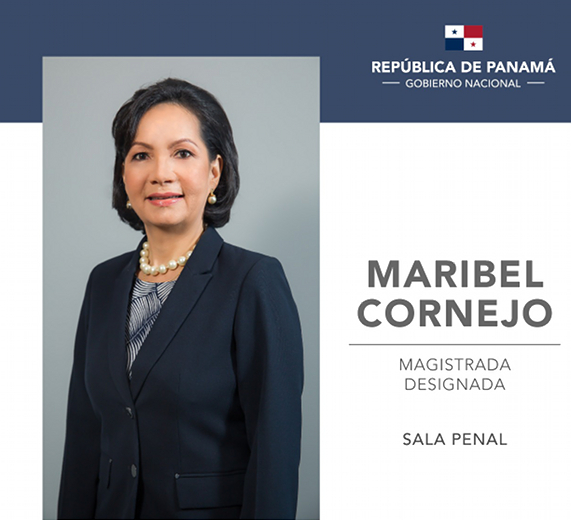
Looking at the three magistrate appointees and the six people who were nominated to be suplentes, it’s a mostly white or light-skinned cholo crowd, largely people brought up in the Interior and including several whose professional lives have mostly taken place there, all with Spanish surnames on both paternal and maternal sides. In Panama, as in most of Latin America, the question of who is of which race is never so clear-cut and is not one of the questions asked in our national censuses. But that said, there appear to be no Afro-descended, indigenous or Asian nominees. Several of Cortizo’s nominees have government service careers that began under the dictatorship and several were appointed to things by PRD presidents or the long-time and disgraced former PRD rector of the University of Panama. Even with the rise of would-be social cleansers in Cortizo’s party, his slate of nominees would at first glance be hard for any of the PRD caucus to oppose.
The main question for the deputies, however, and by usual practices that one that is unlikely to be directly asked of the nominees, is how indulgent they will be of legislators’ corruption. Will they continue the high court’s historic non-aggression pact in which ordinarily magistrates don’t convict deputies and deputies don’t convict magistrates? Are they blackmailable to go along? Are they known to do the bidding of any of the powerful families behind some of the legislators or their parties? In another country the nominees’ records in offices and life would be gone over with figurative fine tooth combs, but here the tradition is that members of the National Assembly hardly ever do their homework and hire friends and relatives incapable of these sorts of investigations as their aides. The opacity of court and public records hinders journalists from doing that work instead.
Cortizo took into account the suggestions and criticisms of selected civil society organizations in screening the many applicants for high court posts. He also hired Los Angeles based management consulting firm Korn Ferry to do background checks, psychological testing and other screens on the hopefuls. The screening also looked into the would-be magistrates’ families.
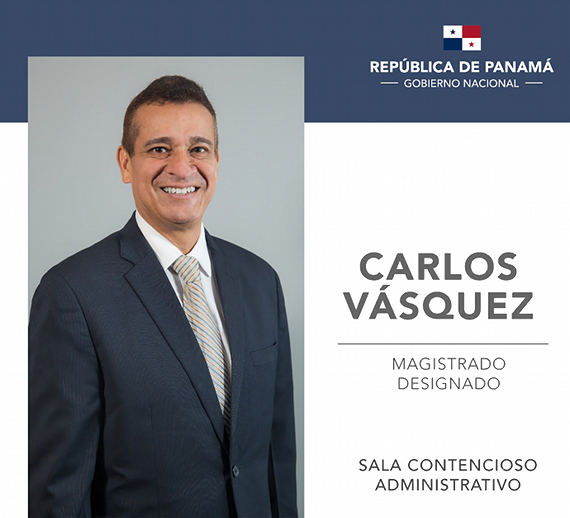
Because of the impasse between Juan Carlos Varela and the National Assembly, over the past few years suplentes and magistrates who were holding over from expired terms until replacements were ratified played outsized roles in high-profile cases. The impression left by that period has been of politicized, squabbling, corrupt and ineffective judicial leadership.
Perhaps the worst parts of it were that as the accusatory penal system was put into place the civil service selection process contemplated in the law was ditched in favor of rather crass favoritism, and that as the municipal corregidores were replaced with justices of the peace many of those posts went unfilled. The Supreme Court exercises broad supervisory powers over all lower courts and might, if it sees fit, have a lot of damage to repair. If the judiciary’s staffing messes are to be cleaned up, a lot of that job might be assigned to suplentes.
(Let’s not, however, look at the high-profile corruption cases that have been handled in ways to incite public scorn as generally indicative of the lower courts. For a long time a general rule of thumb is that the lower down the judicial hierarchy, the more honest the judging is. It’s the high court itself that has been the principal emporium for outrageous behavior. Notice that Cortizo’s appointees have largely been from outside of that rarefied and suspect environment.)
Choose your political spin, or mix and match, maybe taking into account what other spinmeisters have to say. The appointment of two-thirds of the suplentes, along with a third of the magistrates in principal, will radically change the face of the court and may isolate the practitioners of the games that so annoy the public at large. But it might also mean just the same, with a more PRD orientation
The suplente (alternate) nominees include:
– Carmen Luz De Gracia Jurado, who got her start in the Public Ministry in Omar Torrijos times, was a civil judge and then a labor court judge in Noriega times, and after the invasion was a penal judge and then an appeals magistrate in Panama City’s Third Circuit. She’s appointed to be the Civil Bench alternate for Angela Russo.
– Juan Francisco Castillo Canto, a 36-year legal system vet, back to the dictatorship days. Educated at the University of Panama and in Spain, he started out as a court reporter and court clerk in Panama City’s juvenile court, then as a municipal judge in Panama City, then in Chitre. For two years he was a suplente on the high court’s civil bench, appointed to that post by Martín Torrijos. He has for the last decade occupied judicial posts and taught law at various places in the Central provinces. He is nominated to be the Penal Bench suplente for María Eugenia López.
– Miguel A. Espino González is from David and got his undergraduate law degree at the University of Panama, then a doctorate in Argentina. A banking law expert, he worked for USAID and the Inter-American Development Bank. He would be the Civil Bench alternate for Olmedo Arrocha.
– Otilda Vergara Cano de Valderrama, a santeña from Paritilla and quite the honor student all of her live, is a 35-year court system veteran, largely as a criminal court and criminal appeals judge in Los Santos and Herrera. While on the bench she has also been a law professor on the side. She is tapped to be the Penal Bench suplente for Maribel Cornejo.
– Rafael Murgas Torraza, from Santiago, has put in 25 years as a University of Panama law prof and is currently a labor tribunal judge. He would be the Administrative Bench stand-in for Cecilio Cedalise.
– José Agustín Delgado Pérez, from Santiago, first began working in the legal system in Omar Torrijos times. He has been a high school teacher and was a member of the committee that wrote Panama’s basic juvenile code. Delgado would be the Administrative Bench suplente for Carlos Vásquez.
Contact us by email at fund4thepanamanews@gmail.com
These links are interactive — click on the boxes
 Fake news works at a cognitive level to shape our perceptions and drive our decisions. Shutterstock
Fake news works at a cognitive level to shape our perceptions and drive our decisions. Shutterstock“Fake news” is a relatively new term, yet it’s now seen as one of the greatest threats to democracy and free debate. In the Netflix documentary The Great Hack — which chronicled the rise and fall of Cambridge Analytica — we saw how Facebook data was used to target potential voters with insidious right-wing propaganda packaged as if it were news.
But how does fake news work? Neuroscience can provide at least some insight.
The first job of fake news is to catch our attention, and for this reason, novelty is key. Psychologists Gordon Pennycook and David Rand suggested that one of the reasons hyperpartisan claims are so successful is that they tend to be outlandish.
In a world full of surprises, humans have developed an exquisite ability to rapidly detect and orient towards unexpected information or events. Novelty is an essential concept underlying the neural basis of behavior, and plays a role at nearly all stages of neural processing.
Sensory neuroscience has shown that only unexpected information can filter through to higher stages of processing. The sensory cortex may have therefore evolved to adapt to, to predict, and to quiet down the expected regularities of our experiences, focusing on events that are unpredictable or surprising. Neural responses gradually reduce each time we are exposed to the same information, as the brain learns that this stimulus has no reward associated with it.
Novelty itself is related to motivation. Dopamine, a neurotransmitter associated with reward anticipation, increases when we are confronted by novelty. When we see something new, we recognize its potential for rewarding us in some way. Further studies show that the ability of the hippocampus to create new synaptic connections between neurons (a process known as plasticity) is increased by the influence of novelty. By increasing the plasticity of the brain, the potential for learning new concepts is increased.
The primary region involved in responding to novel stimuli — the substantia nigra/ventral segmental area or SN/VTA — is closely linked to the hippocampus and the amygdala, both of which play important roles in learning and memory. While the hippocampus compares stimuli against existing memories, the amygdala responds to emotional stimuli and strengthens associated long-term memories.
This aspect of learning and memory formation is of particular interest to my own lab, where we study brain oscillations involved in long-term memory consolidation. This process occurs during sleep, a somewhat limited time frame to integrate all of our daily information. For this reason, the brain is adapted to prioritise certain types of information. Highly emotionally provocative information stands a stronger chance of lingering in our minds and being incorporated into long-term memory banks.

The allure of fake news is therefore reinforced by its relationship to memory formation. A recent study, published in Psychological Science, highlighted that exposure to propaganda may induce false memories. In one of the largest false-memory experiments to date, scientists gathered up registered voters in the Republic of Ireland in the week preceding the 2018 abortion referendum.
Half of the participants reported a false memory for at least one fabricated event, with more than one third of participants reporting a specific, “eye-witness” memory. In-depth analysis revealed that voters were most susceptible to forming false memories for fake news that closely aligned with their beliefs, particularly if they had low cognitive ability.
The ability of fake news to grab our attention and then highjack our learning and memory circuitry goes a long way to explaining its success. But its strongest selling point is its ability to appeal to our emotions. Studies of online networks show text spreads more virally when it contains a high degree of “moral emotion,” which drives everything we do.
Decisions are often driven by deep-seated emotion that can be difficult to identify. In the process of making a judgment, people consult or refer to an emotion catalogue carrying all the positive and negative tags consciously or unconsciously associated with a given context.
We rely on our ability to place information into an emotional frame of reference that combines facts with feelings. Our positive or negative feelings about people, things and ideas arise much more rapidly than our conscious thoughts, long before we’re aware of them. This processing operates with exposures to emotional content as short as 1/250th of a second, “an interval so brief that there is no recognition or recall of the stimulus.”
Merely being exposed to a fake news headline can increase later belief in that headline, so scrolling through social media feeds laden with emotionally provocative content has the power to change the way we see the world and make political decisions.
The novelty and emotional conviction of fake news, and the way these properties interact with the framework of our memories, exceeds our brains’ analytical capabilities. Though it’s impossible to imagine a democratic structure without disagreement, no constitutional settlement can function if everything is a value judgement based on misinformation.
In the absence of any authoritative perspective on reality, we are doomed to navigate our identities and political beliefs at the mercy of our brains’ more basal functions. The capacity to nurture and sustain peaceful disagreement is a positive characteristic of a truly democratic political system.
But before democratic politics can begin, we must be able to distinguish between opinions and facts, fake news and objective truth.
[ Deep knowledge, daily. Sign up for The Conversation’s newsletter. ]![]()
Rachel Anne Barr, PhD Student, Université Laval
This article is republished from The Conversation under a Creative Commons license. Read the original article.
Contact us by email at fund4thepanamanews@gmail.com
These links are interactive — click on the boxes
El gran compañero, amigo y colega progresista Malcolm Rumbos, nos envió el documento titulado “El País Que Quiere Vivir”, de la pluma solidaria e insobornable del periodista y escritor uruguayo Eduardo Galeano, “sobre la historia del pueblo de Bolivia, de sus sacrificios, de su resistencia heroica frente al saqueo de sus inmensas riquezas”…, martirio que sigue en esta segunda década trágica del siglo XXI, que otros intelectuales solidarios de la Patria Grande deben reseñar, para denunciar a impostores neo fascistas disfrazados de cristianos, entre otros, Luis Fernando Camacho, auto nombrado líder cívico de Santa Cruz de la Sierra, quien utiliza métodos que nos hacen recordar al troglodita brasileño y demás miembros idénticos de un fantasma llamado cartel de Lima.
Cabe destacar que Camacho es parte de Los Caballeros del Oriente, una de las dos grandes logias influyentes de Santa Cruz y es presidente del Comité Pro Santa Cruz, un grupo de instituciones empresariales, vecinales y laborales de extrema derecha. Sus constantes invocaciones a la religión contrastan con una retórica siempre violenta, además que se le tilda de misógino y racista. En concreto, es “una expresión de la derecha protofascista” boliviana.
Junto a su familia integra el Grupo Empresarial de Inversiones Nacional Vida S.A., compañías vinculadas a los seguros, el gas y los servicios. Al respecto, Hugo Siles, politólogo y exministro de Autonomía en Santa Cruz señaló al medio alternativo RT:
“Camacho forma parte de una familia acaudalada de la zona”. Y precisó: “Antes, cada usuario le costaba de 1000 a 1500 dólares conectarse a la red de gas. Esa era una de las empresas de su familia. Hoy todo eso es gratuito por la política de nacionalización donde el gas es un recurso que los bolivianos hemos recuperado para nuestra economía”. Así relata algunos de los intereses concretos de su clan que fueron tocados por el Gobierno de Morales.
En consecuencia, no hay tal patraña cívico-religiosa, sino que respira por la “herida” a sus intereses económicos. Camacho preside desde febrero del presente año, el “Comité pro Santa Cruz, una organización que aglutina diferentes entidades vecinales, zonales, empresariales, de trabajadores de una de las zonas más ricas de Bolivia. La región produce el 70 % de los alimentos del país y tiene un enorme potencial energético e hidrocarburífero que, tras la nacionalización de Morales en 2016, está hoy en manos del Estado.
Más clara no puede ser la razón esta vorágine interminable de racismo y violencia contra hermana(o)s originaria(o)s, en una tierra que, tal como reseñó Galeano, Bolivia “EL PAÍS QUE QUIERE VIVIR”, es una fatal historia que no termina y que debe –debemos- seguir escribiendo, como denuncia frontal de los demonios con el ropaje de cristianos, todos al servicio de la bestia (666) mayor, el imperio genocida, neo liberal depredador de los recursos estratégicos de países hermanos. En tanto, les enviamos este documento fundamental. Fraternal saludo y adelante, siempre adelante.
El autor es fundador y directivo de la Asociación Americana de Periodistas Bolivarianos, Capítulo de Panamá, de la Red Bolivariana “Victoriano Lorenzo”, Héroe de la Revolución Libertaria, en Defensa de la Humanidad, del Comité Panameño de Solidaridad con Bolivia y de la Comisión Anti Bélica de Panamá.
THE SECRETARY OF THE NAVY
WASHINGTON DC 203504000
24 Nov 19
Dear Mr. President:
It has been the extreme honor of a lifetime to stand alongside the men and women of the Navy and Marine Corps team in the protection of the American people and the values we all hold dear.
Together we have made great strides over the past two years, strengthening the foundation of our readiness, and bolstering our constellation of allies and partners, to respond wherever needed with the honor and professionalism that have marked our force for the past 244 years.
Now more than ever, the United States Navy and Marine Corps stands ready and firm in every part of the globe, fueled at all times by our greatest resource the men and women who wear the uniform. Many of them will soon miss their Thanksgiving dinners at home so that they can continue the watch beyond the curve of the horizon. They and their families are, and will forever be, my personal heroes.
As Secretary of the Navy, one the most important responsibilities I have to our people is to maintain good order and discipline throughout the ranks. I regard this as deadly serious business. The lives of our Sailors, Marines and civilian teammates quite literally depend on the professional execution of our many missions, and they also depend on the ongoing faith and support of the people we serve and the allies we serve alongside.
The rule of law is what sets us apart from our adversaries. Good order and discipline is what has enabled our victory against foreign tyranny time and again, from Captain Lawrence’s famous order “Don’t Give up the Ship,” to the discipline and determination that propelled our flag to the highest point on lwo Jima. The Constitution, and the Uniform Code of Military Justice, are the shields that set us apart. and the beacons that protect us all. Through my Title Ten Authority, I have strived to ensure our proceedings are fair, transparent and consistent, from the newest recruit to the Flag and General Officer level.
Unfortunately it has become apparent that in this respect, I no longer share the same understanding with the Commander in Chief who appointed me, in regards to the key principle of good order and discipline. I cannot in good conscience obey an order that I believe violates the sacred oath I took in the presence of my family, my flag and my faith to support and defend the Constitution of the United States.
The President deserves and should expect a Secretary of the Navy who is aligned with his vision for the future of our force generation and sustainment. Therefore, with pride in the achievements we’ve shared, and everlasting faith in the continued service and fidelity of the finest Sailors, Marines and civilian teammates on Earth. I hereby acknowledge my termination as United States Secretary of the Navy, to be effective immediately.
I will forever be grateful for every opportunity to have served. from my days as a Marine. to the extreme honor of serving as the 76th Secretary of the Navy. My wife Polly and I stand in appreciation and admiration of the patriots who today forge the next link in the unbroken chain of our Navy and Marine Corps, and we urge all Americans to keep them, and their families, in their hearts and prayers through this holiday season and beyond.
Thank you once again for the opportunity to serve.
Respectfully yours,
Richard V. Spencer
Contact us by email at fund4thepanamanews@gmail.com
These links are interactive — click on the boxes
Contact us by email at fund4thepanamanews@gmail.com